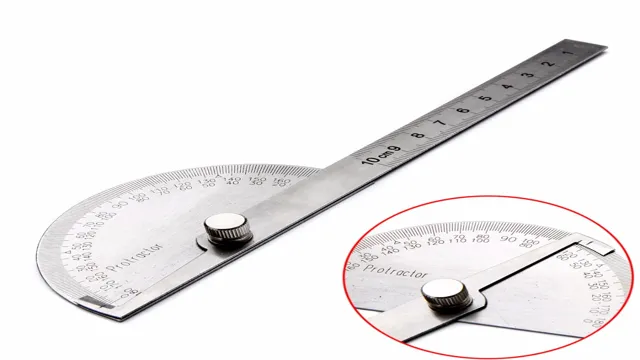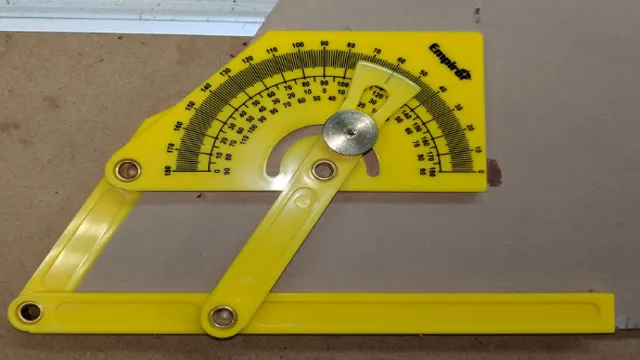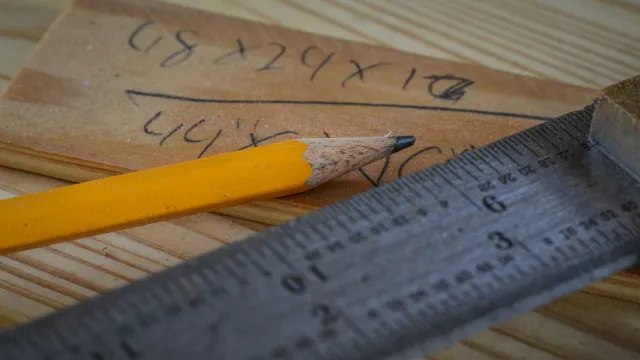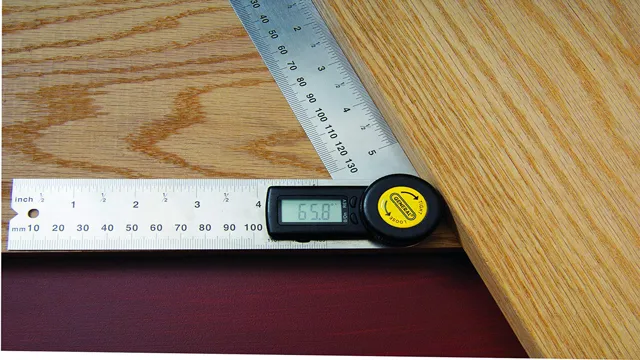How to Find Angle Without Angle Finder: Easy Tips and Tricks
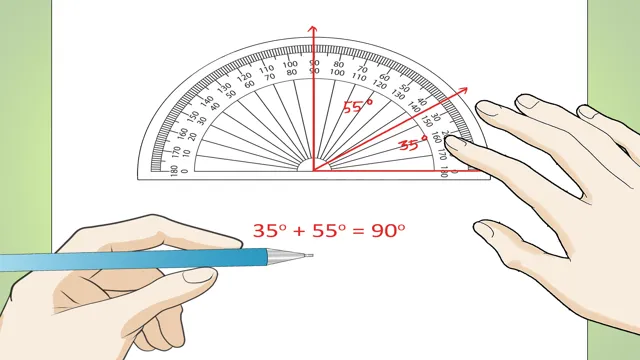
Have an upcoming DIY project that requires precise angles but don’t have an angle finder on hand? Don’t worry, you don’t need a fancy tool to get the job done. In fact, finding angles without an angle finder is a skill that can be learned and mastered with a few simple techniques. Whether you’re working on a construction project, installing new cabinets, or just need to find the right angle for your picture frames, this guide will give you the knowledge and confidence to get the job done accurately and efficiently.
From using basic geometry principles to utilizing everyday tools, we’ve got you covered. So grab your tool belt and let’s dive in!
Using a Protractor
If you don’t have an angle finder but need to measure the angle of a surface, a protractor is a useful tool that can help you achieve accurate results. To use a protractor, first, ensure that the surface on which you want to measure the angle is clean and free from debris. Next, place the protractor on the surface and position it so that the baseline is aligned with the edge of the surface.
Then, look at the protractor’s arc and determine which angle you need to measure. Finally, read the degree markings on the protractor’s arc to obtain your measurement. Remember to take extra care when handling the protractor and ensure that you are reading the correct markings to guarantee accurate results.
With a little bit of practice, you can use a protractor to measure angles without the need for an angle finder.
Measuring Angle with a Protractor
Using a protractor may seem intimidating at first, but it’s a simple tool that can help you measure angles accurately. To start, place the protractor’s flat side along the baseline of the angle you want to measure. Ensure that the baseline sits on the zero-degree mark on the protractor.
Next, align the protractor’s center with the vertex of the angle. Finally, read the degree measurement where the other side of the angle intersects the protractor. Remember that an angle’s degrees always add up to 180 degrees.
So, if you’re measuring an acute angle, the measurement should be less than 90 degrees. Conversely, a measurement greater than 90 degrees means you’re measuring an obtuse angle. With a little practice, using a protractor to measure angles will become second nature to you.
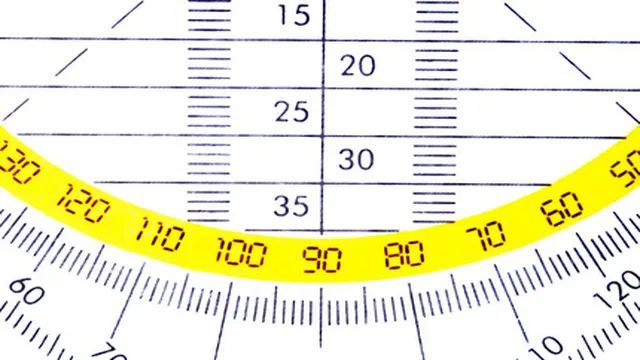
Using a T-Square
If you’re looking for a way to find angles without an angle finder, a T-square might just be the answer you’ve been looking for. T-squares are commonly used in carpentry to align straight edges and help draw perpendicular lines. However, they can also be used to find angles.
To do this, simply place the T-square perpendicular to the edge of the surface you want to measure. Next, align the T-square with the edge of the surface you want to measure. The angle formed between the edge of the surface and the T-square is the angle you’re looking for.
This technique is particularly useful for smaller surfaces or angles that are difficult to measure with a protractor. So next time you need to find an angle and don’t have an angle finder handy, give the T-square a try.
Measuring Angle with a T-Square
A T-square is a handy tool that can help you measure angles with precision. To use a T-square, all you need to do is align the long edge of the ruler with the base of the object you want to measure. Once the ruler is in place, you can use the short edge of the T-square to measure the angle.
Simply place the short edge of the T-square against the object and adjust it until it is aligned with the angle you want to measure. With the T-square in place, you can now measure the angle using a protractor or by reading the markings on the ruler. One thing to keep in mind when using a T-square is to make sure that it is firmly in place before taking any measurements.
If the T-square shifts even a little bit, your measurements can be off by several degrees. So take your time and make sure everything is lined up properly before proceeding. Overall, using a T-square can make measuring angles a lot easier and more accurate, which is especially important for precision work.
Using a Calculator
If you don’t have an angle finder but need to determine the angle of something, don’t worry! You can use a basic scientific calculator to figure it out. First, measure the length of the two sides of the angle using a ruler or tape measure. Then, enter these values into your calculator using the tangent function (tan).
To do this, press the “tan” key followed by the ratio of the opposite side divided by the adjacent side (in that order). This will give you the tangent of the angle. Finally, use the inverse tangent function (tan^-1 or atan) to find the angle itself.
To do this, press the “tan^-1” key followed by the value of the tangent you just calculated. This will give you the angle in radians, so be sure to convert it to degrees by multiplying by 180/pi or using the degree symbol on your calculator. With these simple steps, you can find the angle you need without the use of an angle finder!
Calculating Angle without a Measuring Tool
Calculating angle without a measuring tool might seem like a daunting task, but with the help of a calculator, it can be a piece of cake. To do this, you need to know a few things beforehand. Firstly, you should have an idea about the angles you want to measure, and secondly, you should know how to calculate the values of sine, cosine, and tangent.
These values are essential as they help to determine the angle of a triangle. Once you have thoroughly understood these concepts, using a calculator is relatively easy. All that needs to be done is to input the values of sine, cosine, or tangent, and the calculator will automatically compute the angle for you.
It’s that simple! You can use this method to measure angles in various applications such as woodworking, construction, or engineering. All you need is a calculator, and you’re good to go!
Conclusion
In conclusion, while an angle finder can be a handy tool to have in your toolbox, don’t underestimate the power of your own problem-solving skills. With just a few mathematical tricks and a bit of ingenuity, you can easily find angles without relying on any special gadgets. So the next time you find yourself without an angle finder, fear not – with a bit of creativity, you can still measure those angles like a pro!”
FAQs
What is the method to find the angle without an angle finder?
You can use the trigonometric ratios or a protractor to measure the angle.
How can you measure an angle using the trigonometric ratios?
You can use the sine, cosine, or tangent function with the sides of the triangle to find the angle.
Can you use a smartphone app to measure angles without an angle finder tool?
Yes, there are many apps available that use the phone’s sensors to measure angles accurately.
What is the most accurate tool to measure angles?
A digital protractor or an electronic level sensor provides the most precise measurements.
Is it possible to estimate an angle without a measuring tool?
Yes, you can use visual cues or compare the angle to known angles to estimate it.
How can you find the angle between two walls without an angle finder?
You can use a plumb bob to make a vertical line on each wall, then measure the angle between the lines using a protractor.
What is the practical application of finding angles without an angle finder?
It can be useful in DIY projects, construction, woodworking, metalworking, or any job that requires accurate angle measurements.

